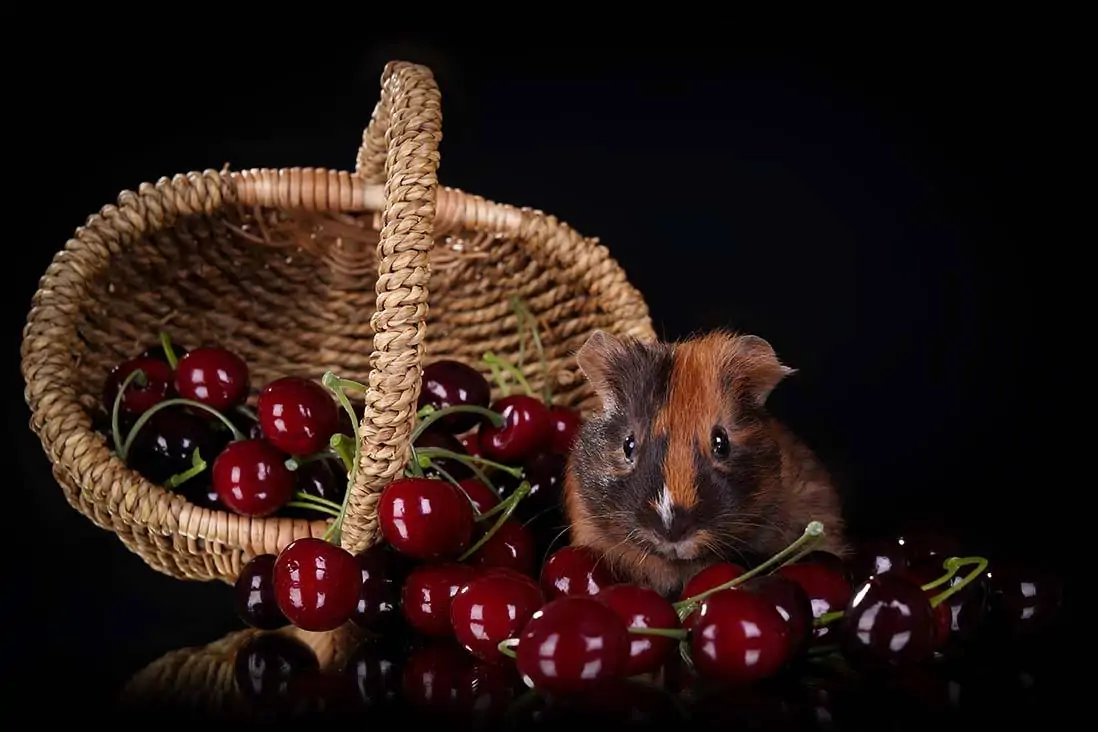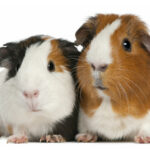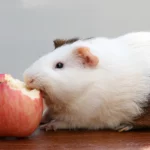Because of their herbivorous diet, guinea pigs naturally produce enzymes that aid in the digestion of fruits and vegetables, including cherries.
Pelletized feed, high-quality hay, fresh fruits, and vegetables make up the bulk of their diet.
Yes, your guinea pig may enjoy this summery treat just as much as you do.
Cherries have a relatively mild flavor and are perfect for sharing with your furry companion. You should serve it as a snack, but only a tiny amount at a time.
The reasons why cherries shouldn’t make up the bulk of their diet will now be presented.
Let’s talk about guinea pigs and cherries because you clearly have questions.
Can Guinea Pigs Eat Cherries?
Have you ever questioned whether or not it’s acceptable to feed your guinea pigs cherries?
A small amount could encourage you to experiment, but you should think carefully before doing so if your pet is involved.
Cherries are a good source of vitamin C and other nutrients that are beneficial to guinea pigs.
It’s best to avoid giving your guinea pigs any part of the cherry plant other than the fruit, including the pit, leaves, and stems, but both sour and sweet cherries are acceptable options.
These components are potentially lethal to your pet since they contain cyanide poisons.
Cherry treats are safe for pets, but like any other food, should be given in moderation.
Cherry servings should be no more than two every feeding, and they should be provided no more frequently than twice per month.
Overfeeding your guinea pigs with cherries can lead to obesity and diabetes.
Cherry pie is a favorite treat of guinea pigs.
Nutrition in cherry
| Nutrients | Amount |
|---|---|
| Vitamin C | 7 mg/ 100 g |
| Vitamin K | 2.1 µg/100 g |
| Vitamin A | 3 µg/ 100 g |
| Carotene | 38 µg/ 100 g |
| Lutein + Zeaxanthin | 85 µg/ 100 g |
| Calcium | 13 mg/ 100 g |
| Phosphorous | 21 mg/ 100 g |
| Potassium | 222 mg/ 100 g |
| Fiber | 2.1 g/ 100 g |
| Sugar | 12.82 g/ 100 g |
| Magnesium | 11 mg/ 100 g |
| Carbs | 16.01 g/ 100 g |
| Calories | 63 Kcal |
| Fat | 0.2 g/ 100 g |
| Water | 82.25 g/ 100 g |
Here are some of the most important vitamins and minerals that cherries contain:
- Melatonin: Melatonin is an enzyme that is found in cherries and can help control how much sleep you get. The main way it works is by adjusting the body’s internal clock. It also calms the mind and helps people get a good night’s sleep.
- Anthocyanins: Another rare enzyme found in cherries is anthocyanin. This enzyme helps control blood pressure and reduces inflammation. It also helps keep your heart in good shape.
- Vitamin C: Cherries also have a small amount of Vitamin C. It is an important vitamin that helps fight diseases, boosts the immune system, and keeps people from getting things like scurvy.
- Vitamin A and Carotene: Other important vitamins found in cherries are vitamin A and beta carotenes. These vitamins help your eyes stay healthy, your hair and skin grow well, and your immune system works better.
- Lutein and Zeaxanthin: Antioxidants like Lutein and Zeaxanthin are also found in cherries. Free radicals are bad for the body, and these antioxidants help fight them. These enzymes also help keep the body’s cholesterol level stable and help the eyes see better.
Why You Should Feed Cherries to Guinea Pigs
Feeding cherries to your guinea pig can have many positive effects. Below is a list of just a few of them:
1. Prevents Scurvy
Scurvy is one of the most dangerous infections your cavy can get. The first sign of this illness is a roughening of the fur, followed by more severe symptoms including bleeding and discharge.
Cherries’ vitamin C content makes them a useful tool in the fight against this disease in guinea pigs.
2 . Cardio Benefits
Your guinea pig’s heart and blood vessels will thank you for giving it only one cherry.
Guinea pigs benefit from the fruit’s ability to control their cholesterol and blood sugar levels. Conditions like heart disease are greatly minimized.
3. Digestion
Due to the small size of their digestive tract, guinea pigs can benefit greatly from cherry juice.
Cherries’ high fiber content makes them a healthy digestive aid.
4. Stimulation
A guinea pig that gets its fill of cherries is less likely to get overweight. The cavy’s metabolism will be revved up, especially if it has been sluggish.
If you want to give your recuperating pig some extra pep, try feeding it a cherry.
5. Good Sleep
If your pig is acting grumpy because it didn’t get enough rest, a cherry might do the trick.
6. Oral Health
The cherry’s high fiber content can aid in your guinea pig’s dental hygiene. It aids in keeping their teeth at a healthy and manageable length.
It promotes healthy teeth and a normal length for their jaws.
7. Boost Immune System
Cherries, in case you didn’t know, are a potent antidote to a number of ills, including cancer, heart disease, and arthritis.
The nutritious content of these fruits is high enough to provide the pigs with protection from disease.
8. Improves Overall Body Activity
Since they are rich in antioxidants, cherries can keep the overall internal body operational and active.
The fruits also have anti-inflammatory properties, thanks to the high ORAC value they possess.
9. High Water Content
Any pet parent knows the headache of getting them to drink some water.
When your guinea pig munches on cherries, they won’t need to drink lots of water since they’d have some in their system.
If you need to increase fluids to your cavy’s diet, cherries will come in handy.
How to Feed Cherries to Your Guinea Pig
With care and consideration, select only the freshest cherries to feed the pigs.
Their nutritional value exceeds that of the overstayed ones.
Then, you need to give them a good scrub to get rid of the pesticides used on them while they were growing.
Second, as guinea pigs shouldn’t eat the stems, pits, or leaves, remove them. Fruit-only diet. Give the pig one cherry, which can be served in bite-size pieces.
Risks to Consider When Feeding Cherries to Guinea Pigs
The acidic cherry juices might burn their mouth and make it difficult for them to eat after eating too many cherries, even if they are hungry.
When you see this happening, cut back on the number of cherries you feed them.
They should be fed organic cherries that have not been treated with pesticides or other toxins.
Leaves, pits, and stems of cherries should be discarded. They all contain cyanide which is exceedingly deadly and dangerous.
Make sure you separate the stem from the cherry and also portray them before giving it to the guinea pig. Please ensure that you feed your piggy with the flesh exclusively.
Cherry consumption might cause constipation due to its high fiber content (around 2.5 grams per cup).
To prepare them for your pig, you must first properly clean them, then cut off any remaining stems, leaves, and seeds.
If you are giving cherries to your guinea pig for the first time, keep an eye out for any adverse reactions.
When you see any strange behavior, it is best to cease feeding them with cherries.
How many cherries can guinea pigs eat?
The acidic cherry juices might burn their mouth and make it difficult for them to eat after eating too many cherries, even if they are hungry.
When you see this happening, cut back on the number of cherries you feed them.
They should be fed organic cherries that have not been treated with pesticides or other toxins.
Leaves, pits, and stems of cherries should be discarded. They all contain cyanide which is exceedingly deadly and dangerous.
Make sure you separate the stem from the cherry and also portray them before giving it to the guinea pig. Please ensure that you feed your piggy with the flesh exclusively.
Cherry consumption might cause constipation due to its high fiber content (around 2.5 grams per cup).
To prepare them for your pig, you must first properly clean them, then cut off any remaining stems, leaves, and seeds.
If you are giving cherries to your guinea pig for the first time, keep an eye out for any adverse reactions. When you see any strange behavior, it is best to cease feeding them with cherries.
Can guinea pigs eat cherries with pits?
The cherry pit is not edible for guinea pigs. It has been scientifically shown that the cyanide included in apple and cherry seeds can cause the untimely demise of your guinea pigs.
Therefore, before feeding cherries to your guinea pigs, you should always remove the pit.
Can guinea pigs eat cherry tree leaves?
Guinea pigs should not be fed cherry tree leaves.
Cherry tree leaves feature a thin serration, or little toothed edge, that could be harmful to your guinea pig’s neck and body.
Also, there are small amounts of prussic acid (hydrogen cyanide), which is toxic to and will kill our guinea pigs.
Thus, keep your guinea pigs away from cherry tree leaves.
Can guinea pigs eat the cherry blossom?
Cherry tree blossoms are not edible to guinea pigs.
Cherry tree blossoms have been shown to have low levels of cyanide, which is lethal to our test subjects. If you have guinea pigs, don’t feed them this.
Can guinea pigs eat dried cherries?
Unfortunately, guinea pigs shouldn’t be given dried cherries.
According to research compiled by Foodcentral, dried cherries have over five times the sugar content of their fresh counterparts.
As a result, you shouldn’t eat any dried cherries at all.
Can guinea pigs drink cherry juice?
Due to the high sugar content, cherry juice is not safe for guinea pigs to consume.
We can’t give our guinea pig the ready-made juice on the market since it has harmful additives like preservatives and stabilizers.
Therefore, you should not give your guinea pigs any cherry juice.
Can guinea pigs eat canned cherries?
Canned cherries are not suitable for guinea pigs.
Preservatives and chemicals used in canning are potentially harmful to the health of our guinea pigs.
As a result, don’t give your guinea pigs anything from a can.
Can guinea pigs eat frozen cherries?
Frozen cherries are safe for guinea pigs to consume, but they need to be thawed and served at room temperature first.
Providing your guinea pig with cold or frozen food can be harmful to its digestive tract.
And it can cause gastrointestinal problems like diarrhea in guinea pigs.
If you choose to feed your guinea pigs frozen cherries, you must thaw them to room temperature first.
How to prepare a cherry for your cavies?
For your guinea pigs, preparing cherries can be a quick and easy task.
But there are a few things you need to make sure of. This is the easy procedure to follow:
- Pick choose a cherry that’s nice and ripe for your guinea pigs. It can be difficult to pick a perfectly ripe cherry. Pick cherries that feel hefty for their size, have shiny skin, and have a healthy stem. While sour cherries lose their stems as they ripen, sweet cherries keep theirs intact.
- The cherry should be washed well in the second stage. Remove any dirt or chemicals that may have accumulated on the skin.
- Deseeding the cherry is the third process. Before serving, make sure the cherry has been trimmed off its twig and the seed has been removed.
- The cherry can now be fed either by hand or mixed in with other vegetables.
- Finally, if you want to keep the cage free of pests like flies and rodents, you should get rid of any uneaten fruits and vegetables.
Why Should You Do Away with the Stem, Leaves, and Pits?
These three locations contain cyanide residue lethal to pigs because of their small size.
Prussic acid, found in the leaves, degrades into cyanide when the plant dies.
There is also a little amount of cyanide in the seeds or pits. Don’t give the cavy any cherry with the pits still inside.
Conclusion
Are you still on the fence about giving your guinea pigs cherries?
Your guinea pigs might benefit from eating cherries.
They’re a vital source of hydration, energy, vitamins, minerals, carbs, fiber, and more for your pet.
If you want to keep your guinea pigs safe from the side effects of eating too many cherries, it will help if you pay close attention to the amount you give them.
Do not touch another cherry tree, and stick to serving the fruits.
In doing so, you’ll protect your pet from the potentially dangerous squalid dwellings that may be found in the plant’s leaves, seeds, and stems.
Your guinea pigs will thrive on organic, seedless cherries.
If you’re going to give your pet cherries, make sure they’re the right kind.






